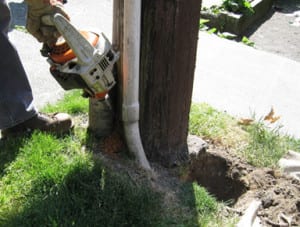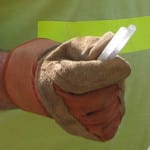
If you spot a bunch of new electric poles in your neighborhood or street, you could be witnessing City Light’s enhanced effort to inspect and treat every single pole in distribution system.
Since 2011, City Light has implemented a formal schedule and procedure for regular inspections and treatment of the 92,000 light poles in our service area. Contractors hired by City Light are currently inspecting each pole and drilling test holes near the pole bases, to gauge the condition of the wood.
The visible conditions and core test data are entered into a computer program that calculates the remaining strength of the pole. If it is too damaged, workers schedule it for replacement. But if a pole shows enough integrity to provide continued service, workers insert several preservative treatment rods into the wood.
The rods gradually infuse the pole with borax or fluoride-based preservatives – safer and non-polluting chemicals – to inhibit fungus and bacteria that eat the wood.
The inspection and treatments can add anywhere from five t o 20 years of service life to a pole, at a cost of less than $20 per pole. By comparison, a new pole can cost as much as $8,000. The plan is to continuously test and treat approximately 10 percent of our inventory every year, so that the entire system gets a checkup every 10 years.
o 20 years of service life to a pole, at a cost of less than $20 per pole. By comparison, a new pole can cost as much as $8,000. The plan is to continuously test and treat approximately 10 percent of our inventory every year, so that the entire system gets a checkup every 10 years.
The new testing procedure is a return of sorts to the past. Records indicate that City Light performed this same type of “Test & Treat” program in the 1950s and early 1960s, as well as periodically in the 1970s and 1980s. Unfortunately, the 1990s saw an industry-wide reduction in this type of basic preventative maintenance and City Light was no exception. Over time, the utility chose instead to rely on initial factory preservative treatment methods and visual inspections by field workers.
Things changed in 2009, when City Light began a systematic inventory of all of its equipment and assets. At that time, workers recorded and did a triage inspection of all poles in the system that carried electrical, cable and phone lines. That census combined with a follow-up inspection program in 2011 to 2013 identified 9,800 poles for replacement.
City Light has also improved the preservation methods for its poles, to make sure that they are safer for the environment. In the past, most utilities relied on very toxic chemicals such as creosote, tar and even asbestos as part of the preservative formula. Today, poles are treated at the mill with copper naphtenate, a lox-toxicity preservative that is less likely to leach into the ground near the pole. City Light also uses plastic liners for the buried part of a pole, to keep moisture, insects and microbes from damaging the wood.
The testing and treatment program is managed by City Light Strategic Advisor Dave Albergine, with assistance from Pole Engineer Ryan Taggart. Brad Combs and Steve Crume have also been long-time champions of methodology. Their work set the direction of today’s program to take the best possible care of our wood poles.
